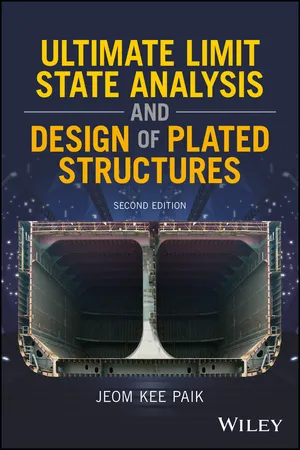
- English
- ePUB (mobile friendly)
- Available on iOS & Android
Ultimate Limit State Analysis and Design of Plated Structures
About This Book
Reviews and describes both the fundamental and practical design procedures for the ultimate limit state design of ductile steel plated structures
The new edition of this well-established reference reviews and describes both fundamentals and practical design procedures for steel plated structures. The derivation of the basic mathematical expressions is presented together with a thorough discussion of the assumptions and the validity of the underlying expressions and solution methods.
Furthermore, this book is also an easily accessed design tool, which facilitates learning by applying the concepts of the limit states for practice using a set of computer programs, which can be downloaded.
Ultimate Limit State Design of Steel Plated Structures provides expert guidance on mechanical model test results as well as nonlinear finite element solutions, sophisticated design methodologies useful for practitioners in industries or research institutions, and selected methods for accurate and efficient analyses of nonlinear behavior of steel plated structures both up to and after the ultimate strength is reached.
- Covers recent advances and developments in the field
- Includes new topics on constitutive equations of steels, test database associated with low/elevated temperature, and strain rates
- Includes a new chapter on a semi-analytical method
- Supported by a companion website with illustrative example data sheets
- Provides results for existing mechanical model tests
- Offers a thorough discussion of assumptions and the validity of underlying expressions and solution methods
Designed as both a textbook and a handy reference, Ultimate Limit State Design of Steel Plated Structures, Second Edition is well suited to teachers and university students who are approaching the limit state design technology of steel plated structures for the first time. It also meets the needs of structural designers or researchers who are involved in civil, marine, and mechanical engineering as well as offshore engineering and naval architecture.
Frequently asked questions
Information
1
Principles of Limit State Design
1.1 Structural Design Philosophies
- Geometric factors associated with structural characteristics, buckling, large deformation, crushing, or folding
- Material factors associated with chemical composition, mechanical properties, yielding or plasticity, or fracture
- Fabrication related initial imperfections, such as initial distortion, welding induced residual stress, or softening
- Temperature factors, such as low temperatures associated with operation in cold waters or low‐temperature cargo and high temperatures due to fire and explosions
- Dynamic or impact factors (e.g., strain rate sensitivity or inertia effect) associated with freak waves and impact pressure actions that arise from sloshing, slamming, or green water; overpressure actions that arise from explosion; and impact from collisions, grounding, or dropped objects
- Age related degradation factors, such as corrosion or fatigue cracking
- Accident induced damage factors, such as local denting, collision damage, grounding damage, fire damage, or explosion damage
- Human factors related to unusual operations (e.g., ship’s operational speed compared with maximum permitted speed or acceleration, ship’s heading, or loading or unloading conditions)

Table of contents
- Cover
- Title Page
- Table of Contents
- Preface
- About the Author
- How to Use This Book
- 1 Principles of Limit State Design
- 2 Buckling and Ultimate Strength of Plate–Stiffener Combinations
- 3 Elastic and Inelastic Buckling Strength of Plates Under Complex Circumstances
- 4 Large‐Deflection and Ultimate Strength Behavior of Plates
- 5 Elastic and Inelastic Buckling Strength of Stiffened Panels and Grillages
- 6 Large‐Deflection and Ultimate Strength Behavior of Stiffened Panels and Grillages
- 7 Buckling and Ultimate Strength of Plate Assemblies
- 8 Ultimate Strength of Ship Hull Structures
- 9 Structural Fracture Mechanics
- 10 Structural Impact Mechanics
- 11 The Incremental Galerkin Method
- 12 The Nonlinear Finite Element Method
- 13 The Intelligent Supersize Finite Element Method
- Appendices
- Index
- End User License Agreement